If you’re a fan of flatbreads, you need to try my Punjabi Makki Ki Roti recipe. This corn-based unleavened flatbreads (sometimes called makki di roti) are delicious, slightly sweet from the maize flour or cornmeal, and perfect for a winter lunch or dinner, especially when served with Sarson ka Saag.

About Makki Ki Roti
Makki ki roti is an unleavened bread that can be made traditionally (in a tandoor), or using a tawa (flat skillet). Makki di roti are popular flatbreads from the land of Punjab. This famous maize flour bread gets its name from the Punjabi term for maize flour: makki ka atta.
While maize is a term for corn, please note that makki ka atta is different than what we know as “cornflour” in India. What we call cornflour is known as “cornstarch” in different parts of the world, while makki ka atta is finely ground cornmeal.
Makki ki roti is most often served with Sarson ka Saag (sautéed and spiced mustard greens) and a few jaggery cubes; this delicious combo is quite famous and is very healthy.
Makki ki roti goes well with any saag, including Palak Saag (made with spinach), bathua saag (cooked with goosefoot leaves) or Chane ka Saag (prepared with chickpea greens). While saag can also be served with Paratha, these maize-flour flatbreads are always the first choice.
Makki ki roti can also be served plain for breakfast with a cup of Chai. You can also make them with some chopped greens like fenugreek (methi), spinach (palak) or goosefoot leaves (bathua) to the maize flour and make parathas. I usually make this for breakfast in the winters.
Makki di roti is a bit heavy on the stomach when compared with other flatbreads, so I like to add carom seeds (ajwain) to help with digestion.
Maize flatbreads have to be cooked properly, or else you might get stomach pain. I learned how to make makki ki roti from my Punjabi mother-in-law, and the method shared here is exactly the way we make it at home.
Hot water is added to the dough to make the makki ka atta more pliable and easier to roll. If you are having difficulty, adding a bit of whole wheat flour (atta) can also make the roti easier to roll.
These maize flour roti can be a little difficult to work with when you first start. As such, I have shown two methods of rolling makki ki roti in the step-by-step photos; use whichever method makes the most sense to you.
I also suggest that you start by making small roti that are easier to handle and then slowly increasing the size of the makki di roti as you become more comfortable.
How to make Makki ki Roti
Make Maize Flour (Cornmeal) Dough
1. In a mixing bowl, take 2 cups maize flour or fine cornmeal (200 grams), 1 teaspoon carom seeds (ajwain) and salt to taste. Mix everything together with a spoon.
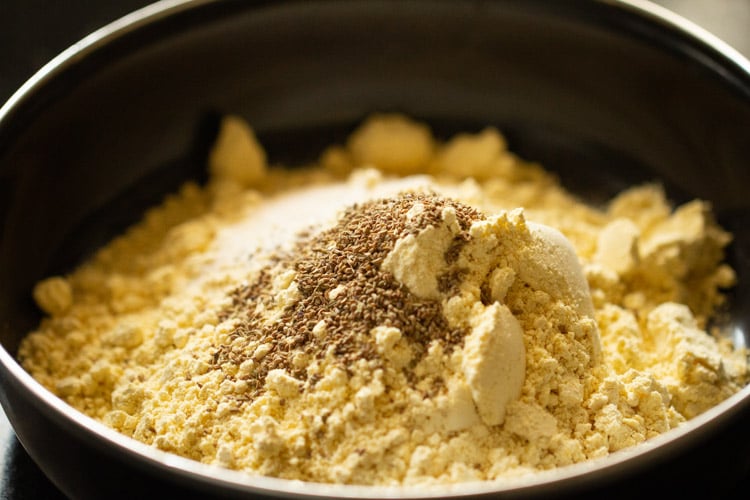
2. Heat 1 cup water in a separate pan till it comes to a boil. Add this hot water to the flour mixture.

3. Mix with a spoon. Cover and keep aside till the dough cools enough to handle.

4. When the mixture is cool enough to handle, begin to knead to a smooth yet firm dough.
TROUBLESHOOTING TIP: If the dough looks or feels dry, then add some warm water. If the dough feels sticky, then add a few tablespoons of maize flour.

5. As you can see in the photo below, the final dough will have some fine cracks present. This is to be expected.

6. Make medium sized balls of dough, shaping them into a neat balls and flattening them slightly with your palm.

Rolling Method 1 – Rolling Pin
7. Sprinkle some maize flour on the rolling board. Place the dough ball on the rolling board. Then sprinkle some maize flour on the dough ball also.

8. Begin to gently roll with a rolling pin (belan). Sprinkle some flour. Now with the rolling pin (belan), slowly roll.
Using ziplock bag: If you don’t have a rolling pin, you can also “roll” the makki ki roti using a ziplock bag. Place the bag on a cutting board, back of a metal tray, or on a surface you can move.
Place the dough ball in the bag. Press it slightly with your hands until flat. The using the rolling pin roll gently to about a size as thin as a tortilla. Move the rolling board and roll again. This is to ensure that all the sides of the makki roti are evenly rolled.

9. Roll into small- to medium-sized rounds. They should be roughly the size of a phulka or chapati, but not very thin. The roti should not break if you handle them carefully. If the rolling pin is sticking, add more flour as required.

Rolling Method 2 – Hand Shaping
10. Makki roti can also be made by patting the dough. To start, sprinkle some maize flour on the dough ball and on the rolling board.

11. Now, with your fingers, gently press and pat the dough. As you press the dough, also move it clockwise.

12. Continue to press and pat the dough till you get a neat roti. Do not make thin but slightly thick roti. When the dough is patted, the edges won’t be as even as if you had rolled it; this is fine.
If you are experienced in making the roti by pressing the palms of your hands together the way our grandmothers and great-grandmothers used to, feel free to make the makki roti this way too.
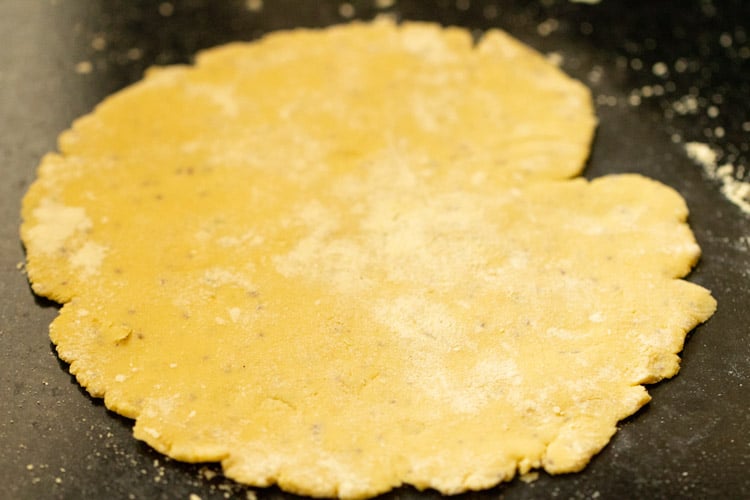
Cook Makki Ki Roti
13. Now spread about 1 to 2 teaspoons of ghee or a neutral flavored oil on a hot tawa or skillet or frying pan. Cook the roti on medium to medium-high heat.
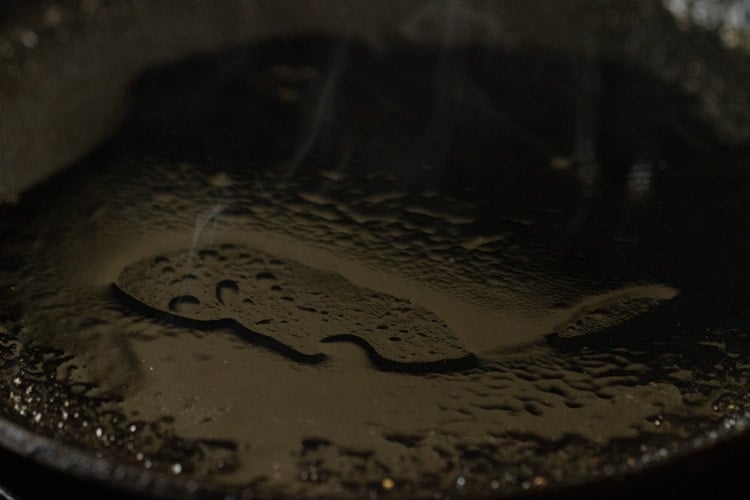
14. Gently place the makki di roti on the tawa. If there is a crack in the roti dough, then gently pat that portion with a few drops of water to seal it shut.
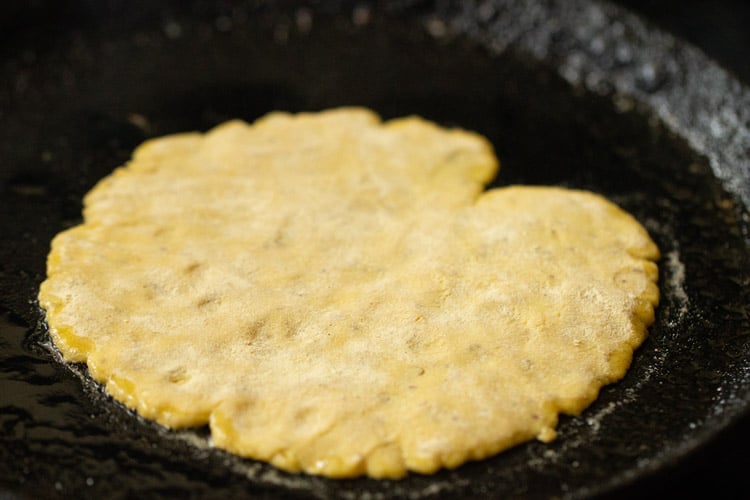
15. When one side is a little browned, flip the makki roti with the help of a spatula.
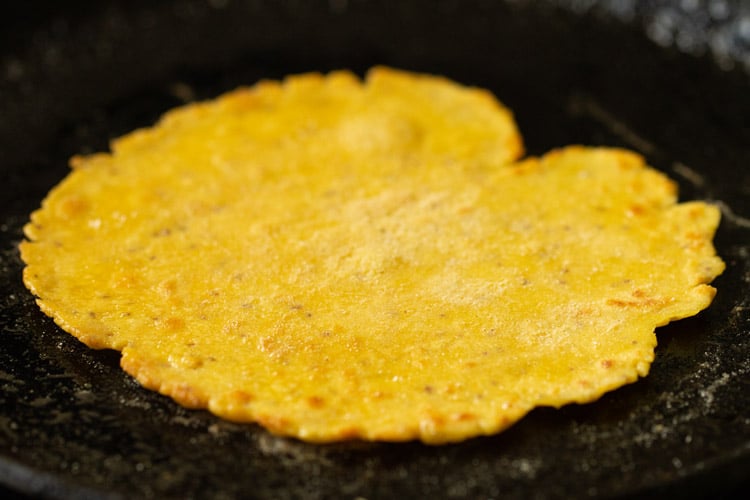
16. When the other side gets browned, flip again. Flip for a couple of times till the makki di roti is well browned and cooked from all sides. Drizzle a bit of ghee on the sides whilst cooking the roti.
If the dough is kneaded well, the makki di roti will start puffing up. Press the edges with a spatula so that the edges are also cooked well. Continue making all rotis this way until the dough is over.
If you like multi-tasking, you can roll and roast the rotis simultaneously. If you prefer working in stages, you can also roll all the makki ki rotis first. Cover them with a kitchen napkin to keep them from drying out, and then roast them one by one.
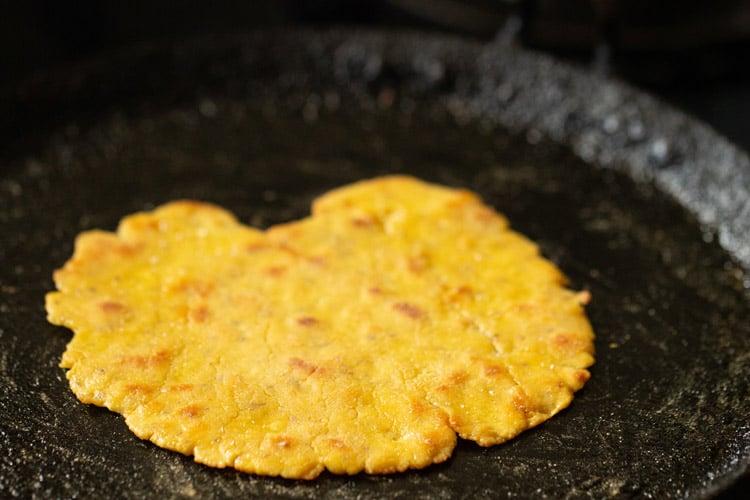
Serve the makki ki roti hot with saag and jaggery cubes. We also like to add some white butter on top of the makki di roti while serving; that’s how they are relished and served in Punjabi families.
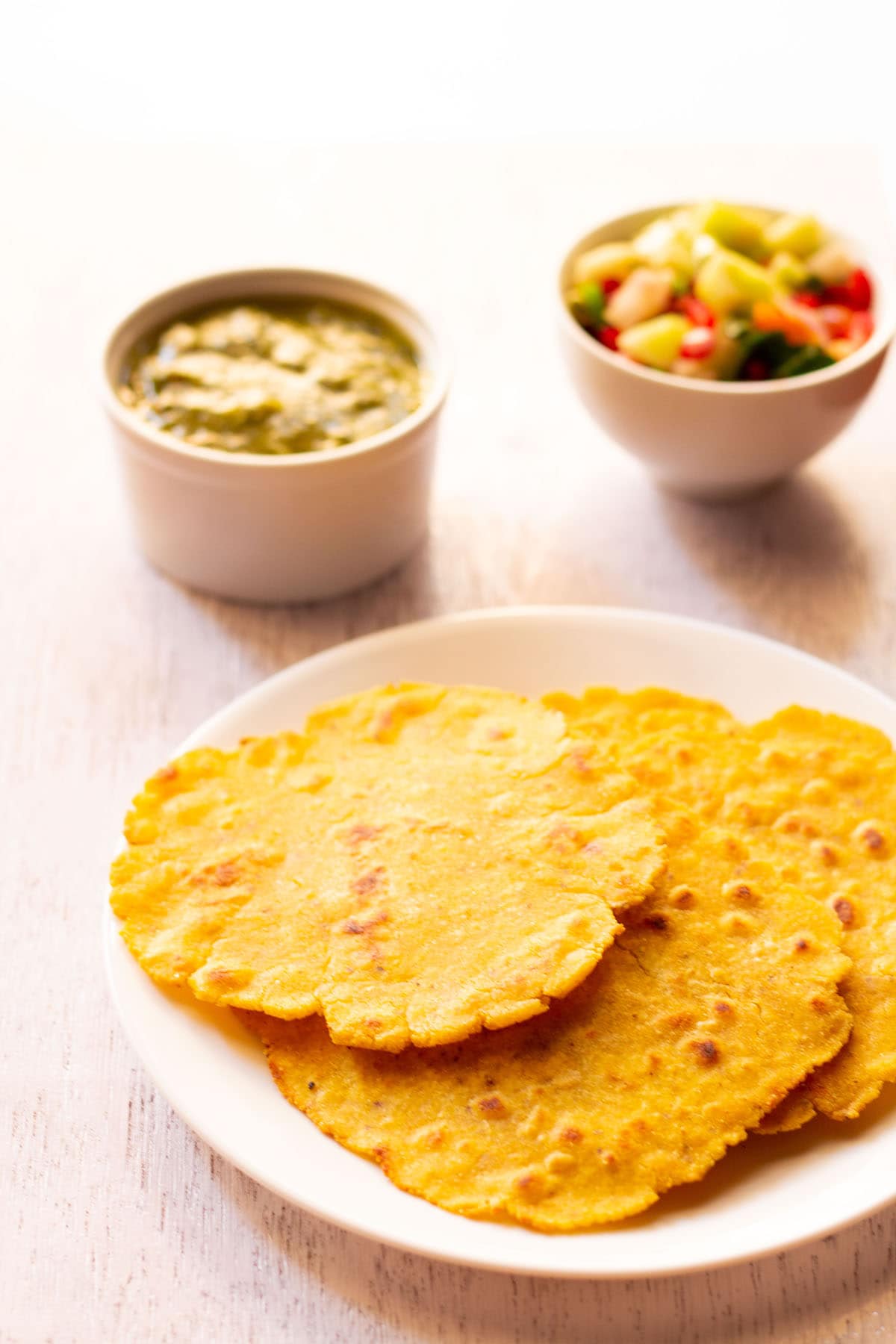
FAQs
While I myself have not tried it, I have heard from several of my readers that they have made this substitution with very good results.
Yes, it would work!
Makki di roti, much like other types of bread, are best served hot or warm. That said, you can make the dough a day earlier and refrigerate it. Cover the dough with a clingfilm or place in an air-tight container so that it does not become dry.
Sure! Once cooked, separate the rotis with pieces of parchment. Place them in a zip top bag and remove as much air as possible. They should keep for up to 2 months in the freezer. To serve, warm them on a tawa until heated through.
These flatbreads are a little harder to roll than other types because maize flour doesn’t have gluten. The gluten creates long strands of protein that help hold everything together. Have you ever rolled out a dough for it to spring back somewhat? That’s the gluten at work!
Using very hot water to make the dough helps somewhat. I also recommend rolling them between pieces of parchment paper or in a zip top bag to help keep things together. Finally, don’t be afraid to use your hands to help press and shape the roti as needed.
If you are *still* having a tough time, you can add a bit of wheat flour (atta) to the dough before rolling, which will add some gluten to help guide you. That said, please note that this is not the traditional method of making makki ka atta, and it will slightly change the flavor of the final product.
Indian Breads
Vegan Recipes
Indian Breads
Please be sure to rate the recipe in the recipe card or leave a comment below if you have made it. For more vegetarian inspirations, Sign Up for my emails or follow me on Instagram, Youtube, Facebook, Pinterest or Twitter.
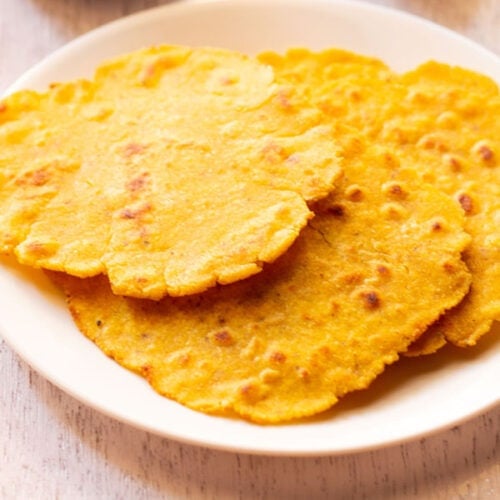
Makki ki Roti (Makki di Roti)
Ingredients
- 2 cups maize flour or cornmeal (makki ka atta) – 200 grams
- 1 cup hot water or add as required
- 1 teaspoon carom seeds (ajwain)
- salt as required
- 5 to 6 tablespoons Ghee or oil or add as required, for roasting
Instructions
Making dough
- In a mixing bowl take the maize flour or cornmeal, carom seeds and salt as required. Mix them together with a spoon.
- Heat water separately in a pan till it comes to a boil. Add this hot water to the flour.
- Mix with a spoon. Cover and keep aside till the dough mixture becomes warm.
- When the mixture becomes warm and the heat is fine to handle, begin to knead to a smooth yet firm dough. If the dough looks dry, then add some warm water. If the dough looks sticky, then add a few tablespoons of maize flour.
- Knead into a smooth yet firm dough. Fine cracks will be there on the dough but not to worry. Make medium sized balls of the dough. Shape them into a neat ball and flatten them.
Rolling – Method 1
- Sprinkle some maize flour on the rolling board. Place the dough ball on the rolling board. Then sprinkle some maize flour on the dough ball also.
- Begin to gently roll with a rolling pin (belan). Add more flour if required.
- Roll to small to medium-sized round circle. Make into the size of a roti or chapati but not very thin, but a little thick.
- You can even use a ziplock bag. If using a ziplock bag, then keep the bag on the rolling board or on a plate or on a surface which you can move. Place the dough ball in the bag. Press it slightly with your hands. Now with the rolling pin, slowly roll. Sprinkle some flour. Move the rolling board and roll again. This is to ensure that all the sides of the roti are evenly rolled.
Rolling – Method 2
- Makki roti can also be made by patting the dough. Sprinkle some maize flour on the dough ball all over and also on the rolling board.
- Now with your fingers gently press and pat the dough. As you press the dough, also move it clockwise. add flour as required when patting the dough.
- Continue to press and pat the dough till you get a neat makki roti. Do not make thin but slightly thick roti. When the dough is patted, the edges won’t be even.
Making makki ki roti
- Now spread some ghee or oil on a hot tawa (skillet) – about 1 to 2 teaspoons of ghee or oil
- Gently place the roti on the tava or griddle. If there is a crack on the roti, then gently and carefully pat that portion with a few drops of water.
- When one side is a little browned, flip the roti with the help of a spatula.
- When the other side gets browned, flip again. Flip a couple of times and cook till the roti is well browned and cooked from all sides. Press the edges with a spatula so that they get cooked well.
- Drizzle a bit of ghee on the sides while cooking the roti. If the dough is kneaded very well, the roti will start puffing up also or you can see the roti puffing at some spots.
- Remove roti from pan and serve hot. Or you can stack them in a roti basket or bundle a stack of them in a clean kitchen cotton towel. Roll and roast the remaining roti this way until all the dough is used up.
- Serve the makki ki roti hot with Sarson ka Saag and jaggery cubes. If you don’t mind then you can add some White Butter (Makhan) on top of the makki di roti while serving them hot. That’s how they are relished and served in Punjabi families.
Notes
Nutrition Info (Approximate Values)
This makki di roti post from the archives first published in January 2012 has been republished and updated on 5 December 2021.
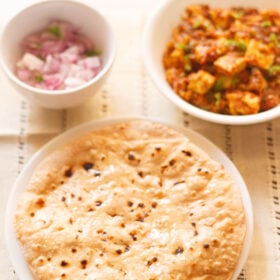
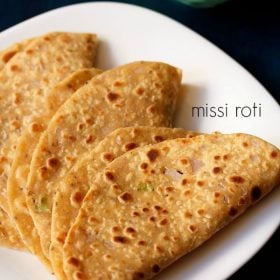
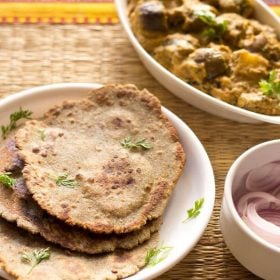
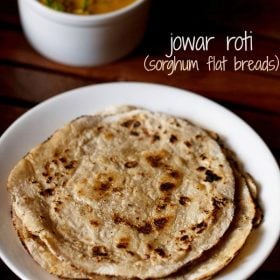
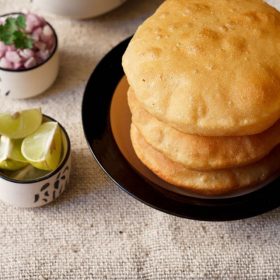
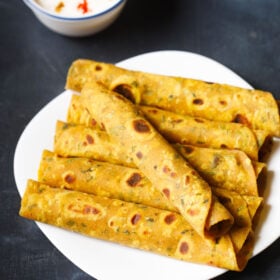
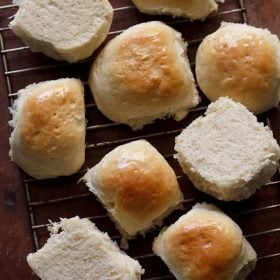
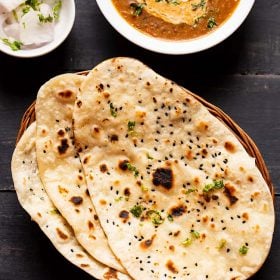








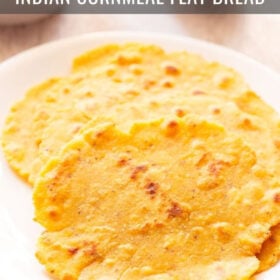
I made makki ki roti along with your sarson ka saag recipe. I have to say, I thoroughly enjoyed the meal.
I turn to your website for all of the dishes I make for the first time. It’s never failed me so thank you so much.
Thank you and so glad and happy to read your comment. Thanks for the rating too.
I love your recipes when I cook I always use your recipes; and thanks 😍
Thanks a lot.
great for beginners like me , Many Thanks
Hello dassana,
I am Mexican ladki married to a Punjabi ladka. I was thrilled when I found out about maki ki roti and found them easier to make than my beginner rotis! We use harina de maíz (corn flour) and it’s easier to knead than corn meal which the granules are bigger. I brought my mother in law my grandmas old cast iron tortilla presser. We also cover it with ziploc and just use slight amount of pressure to the handle to make perfect round tortillas. My mother in law was thrilled and had fun using it.
And yes, they are heavier than rotis and corn really does not have the great nutritional properties that atta has.
Also warm water helps.
Your recipes have really made me a better and more confident Indian cook and I have impressed my mother in law a few occasions with your help.
Gracias! (Thank you)
Welcome Dani. Glad to read your feedback. tortilla presser is a very good idea. Thanks for sharing this information.
you can add grated mooli or methi leaves while making the dough for extra flavour
thanks mamta for this suggestion.
My mom usually makes them at home – perfectly round ones. The trick is that you have to use warm water while flattening them on palm(she makes them on palms) and I agree more water while kneading helps in round rotis. Also elder ones at home say that maize flour is lighter than wheat flour its the sarso ka saag that makes the meal heavy otherwise makki ki roti is light for our stomach. My grandmother usually eats them as she thinks these are light and easy to digest.
agree on warm water for kneading. my mother in law says that makki ka atta is slightly difficult to digest and says that ajwain must be added to the dough. we also have makki ki rotis with tea at times and i do feel they are heavy than chapatis. i can’t make them perfectly round and it takes practice. i only make them during winters and that too with sarson ka saag and on occasions with some mooli chutney or tea.
Hi.. I tried this today and came out very well, but the only thing is my flour is not yellow color, its labelled as sorghum flour ( Jowar ki roti ) so i was wondering both are same or different?
thanks meena. makki ki roti is maize flour and is always yellow in color. the colour resembles the colour of besan/gram flour. both are different. sorghum flour has creamish color.
thanks for the recipe. First time i made this – truly wonderful. My makki rotis looked just like yours. the only difference was I did not use a rolling pin to roll them out. I flattened them in the bag by hand and this was before reading the other comments. I had them with your recipe for Sarson ka saag – this was made for the first time too!!. Will definitely look out for more recipes from you.
welcome mina. thanks for sharing your positive feedback. you can even flatten the roti with your hands. yes do try some more recipes.
nice recipe
Actually, corn meal is whatever color the corn it was made from, white, red, blue, green, or yellow. Your recipe is very much like tortillas. I would recommend trying what the Latinos call “masa harina” next time you are looking for corn meal/flour. A package might also say “masa de maize”. Masa harina is corn flour/meal that has been made into hominy first then ground into a flour and dried. It is more nutritious that just plain ground corn and has a better texture for making tortillas. Latinos will use rolling pins to make tortillas; some will also use a tortilla press. They sometimes also use sheets of plastic to keep the dough from sticking as you do. I recommend looking into a tortilla press if you can. I really learn a lot from your website. Your education in Food Science really comes through. I have also studied Food Science so I know.
in india, locally we only get the yellow colored maize flour. the other colored ones are only available in major indian cities and all of them are imported from other countries and very expensive. i have read about masa harina. in fact was even thinking of making them from the yellow maize flour that we get here. thanks for sharing the info on masa harina and tortilla. also thanks for your kind words.
Hello Amit try the recipe with increasing the amount of water from 1/2 cup to 1-1.25 cups of water. The rotis will come out round circular in shape and won’t be too dry to eat. Using a plastic sheet is a good idea and if you increase the water content then you won’t need a rolling pin instead you can roll it out with the finger tips or even the back of a thali/plate on a flat surface. Objective is to make the dough very soft and if it dries out then wet your hands again and knead it a little bit more.
thanks for the suggestion and tips. i usually make the dough soft, but still that its easier to roll. i will try with your suggestion of adding some more water and making the rotis with the palm of the hand.
Nice it helped me in my cooking my friends told it was fantastic
thanks janani for the positive feedback.
Hi Dassana,
i went thru a lot of your recepies today for the first time. Quite amazing. your amritsari chole is just how i make mine.Your whole wheat naan too good and just like you i can have anything with tea. Be it pakwaan, kulcha or aloo paratha!
thanks hetal.
Will definitely be trying these with the saag, thanks!!
welcome natalie…. do lemme know…
I havent had makki ki roti in a soo long.. mom would make it and give us only one,.. though my grandfather ate a bunch without a problem.. he was from the farming generation. completely different digestive systems and health!
Your id you commented with on my blog isnt linked to here.. but i remembered !
Thank you for the kind words on the posts!
even at home, when i make these, i cannot have more than two small rotis. but my father in law can eat a bunch. i agree with you…. a completely different generation and digestive systems.